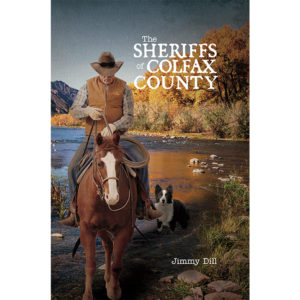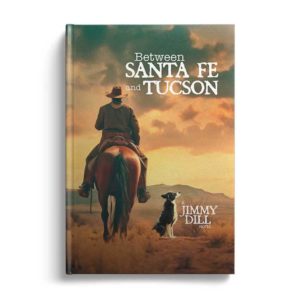
Jimmy Dill
Jimmy Dill grew up in Fairfield, Alabama. He and his wife, Diane, have two daughters and five grandchildren.
They currently reside in Shelby County, Alabama.

The mid-1950’s were mostly times of relative peace. All was not perfect, but no one told that to the young boys of Fair Hills, a small community set in the Deep South. Fair Hills was home to the largest steel mill in the South, seemingly endless woods for hunting and exploring, a baseball field, and a special creek for catching crawfish, and the making and bonding of friendships.
The young boys sometimes experienced adventures that stretch the imagination. On other days, time was spent on the ball field, or hanging out at Crawfish Creek. On many adventures, young eyes anxiously watched out for Red Dog, or for the toad with the missing toe. The readers of The Boys of Fair Hills will hopefully do the same.
$17.50

Tears to Justice is a work of fiction. Upon graduating from West Point in 1838, Second Lieutenant Jacob Johnson fulfilled his father’s dream of having a son serve as a United States Army officer. His father had been orphaned at the age of ten when his parents were killed by Cherokees in the Massacre of Long Cane Creek, South Carolina.
Second Lieutenant Johnson received his first duty assignment at graduation. He was anything but pleased. He was assigned to assist in forcing Cherokee Indians to leave their homes and march to the Oklahoma Indian Territory.
The conditions along the Trail were brutal. The Trail of Tears had earned its name. The lieutenant befriended a young Cherokee woman, Awinita, who was expecting a child. The baby would not wait to be born in Oklahoma. The young lieutenant was given permission to take the expectant mother to a cotton plantation along the Trail, where she gave birth.
The plantation owners were instructed to see that the mother and her baby were placed with the next group of Indians that came along on the Trail. Later, the lieutenant discovered that the mother and her baby had been sold into slavery by the plantation owner.
The lieutenant devoted the rest of his career to seeking justice for those who were forced off of their lands and onto reservations, or who were held in slavery. He was also committed to seek accountability for those who abused others.
After thirty years of military service, and attaining the rank of colonel, many of Colonel Jacob Johnson’s goals had been fulfilled, especially as he fought with General Grant in the War Between the States.

The Sheriffs of Colfax County
The Sheriffs of Colfax County is a work of fiction set in the late 1860’s and early 1870’s. The primary setting is the New Mexico Territory and the surrounding territories and states of the West. The reputation of the West, as being wild and unruly, was often not exaggerated. It was not uncommon for disputes to be settled by the sixgun. County sheriffs and US Marshalls enforced the law, and kept a sense of order as best that they could. Judges administered justice swiftly. It was mostly fair, but always swift.
Mining in the West drew throngs of people seeking to get rich quickly. Outlaw gangs roamed the West looking to profit off of someone else’s labor. The increasing influx of white settlers and miners created conflict, and often violent encounters, with the numerous Indian tribes, who sought to retain their hunting lands and protect their way of life. Along the way were treaties, broken treaties, raids and wars, and ultimately relegation to reservations.
Many a conflict began, and sometimes ended, in the saloons of the wild West. A disputed card game resulted in the father of three Scott brothers being shot. The immediate avenging of the shooting, by one of the brothers who had worn a badge moments before, resulted in the shooting death of one of the Stokes brothers. What resulted from there was months of passionate attempts to achieve total revenge by both families. The paths to achieve vindication stretched from as far as Nevada, all the way to the Atlantic Ocean. Along the way, roles and facts seemed to change, but the goals remained unchanged. The final outcome could not have been easily foreseen, but ultimately the matter was laid to rest, with only one family member left standing.

Colfax to Santa Fe
For Rankin Scott, the former Sheriff of Colfax County in the New Mexico Territory, Pine Canyon afforded him just the right amount of peace and solitude he needed to recover from the previous year. He had become the sheriff to avenge his brother’s murder. MacKenzie Scott had served as the Sheriff of Colfax County before his untimely death.
Rankin’s year-long quest had taken him as far east as Boston, as far north and west as Idaho and Nevada, and as far south as the Mexican border. He was physically and mentally tired. The canyon, and his faithful dog, Buster, were perfect prescriptions for rest and healing.
The peace and solitude of the canyon were suddenly interrupted when he allowed his friend, Judge Walter Freeman, to talk him into becoming the Sheriff of Santa Fe County. A dispute between the Apaches and the Army, and a stagecoach robbery, had lured Judge Freeman to Santa Fe. He had served as the Colfax County Judge for many years.
Rankin hesitatingly joined Judge Freeman for this challenge.
Rankin fully expected to return to the solitude of Pine Canyon when his work in Santa Fe was done. However, Rankin found the challenges in Santa Fe to be everything he had expected and more. So much more that his return to the canyon was placed on hold, perhaps indefinitely.
$17.50

Between Santa Fe and Tucson
Between Santa Fe and Tucson is a work of fiction set in the mid-1870’s. The setting is mostly around Santa Fe in the New Mexico Territory, as well as parts of Colorado and the Arizona Territory.
Between Santa Fe and Tucson continues the story of Sheriff Rankin Scott, who, as the Sheriff of Colfax County, avenged the murder of his brother, MacKenzie, and brought a most unexpected killer, Gloria Stokes, to the type of justice normally reserved for men. Rankin ended the reign of crime of the notorious Carleton Gang, and in so doing formed a bond of friendship with Judge Walter Freeman. Sheriff Scott and Judge Freeman also formed a relationship of respect and friendship with Chief Howling Wolf and the Apache tribe that he led with integrity and fairness.
The westward movement of settlers and land developers placed the Apache tribes at risk of losing their land and being placed on reservations. Lt. Gates, who commanded the Army Post at Fort Wingate, made a move to wage war on the Apaches. Sheriff Scott developed a plan to bluff Gates into backing away from his immediate plan. Rankin’s plan worked, at least for the time being.
In this third book, Between Santa Fe and Tucson, Sheriff Scott and Judge Freeman continued to protect the people of Santa Fe, and to administer justice equitably and fairly. They intervened to save a rancher family from loosing their ranch to unscrupulous gamblers.
When the President of the United States visited Santa Fe, in response to rumors about trouble with the Apaches, Sarah and Rankin were able to have their wedding, and to entertain the president at the same time.
Sheriff Scott, Judge Freeman, and a US Marshal teamed up to thwart a scheme that would accuse Chief Falling Waters and his people of crimes they did not do. Lt. Gates was again involved in the effort to take away the Apaches’ land and herd them onto a reservation. The sheriff, judge, and marshal intervened to help the chiefs in their efforts to make sure that Gates was not successful.
$17.50

Gracie’s Cafe is set in the Deep South during the mid-1950’s. Cain Valley, lying near the southern terminus of the Appalachian Mountains, is a small, mostly-farming community. While most of the Cain Valley residents farm for a living, a few work at jobs in the town, or in a nearby coal mine.
At the center of the town is a fun-loving, eccentric mayor, who is in charge of Cain Valley’s social events. The townsfolk of Cain Valley work hard, and play whenever they can. An unexpected explosion at the mine renders the foreman, Tom Long, unable to return to the mine.
Tom’s wife Gracie, who sees adversity as an opportunity, knows that Tom needs to remain busy and productive. Gracie persuades Tom to purchase the town’s only cafe with the settlement money from his mining accident. The purchase is made, and it is agreed that the cafe will carry Gracie’s name. The couple also purchases the adjacent, vacated building, which soon becomes “Tom’s Piddling Shop.”
Gracie’s Cafe quickly becomes the center of social life in Cain Valley, and doubles as the mayor’s office. The pivotal role that Gracie’s Cafe is to play in the future of the town could not have been foreseen. Life in Cain Valley had been essentially unchanged for decades.
The inadvertent discovery of a Creek Indian Village, below the surface of Cain Valley, leads to an in-depth exploration of the history of the territory prior to statehood. The ownership of the town’s beloved cafe, by a couple with a deep and abiding faith, as well as a strong sense of right from wrong, places the town on a path of confrontation with the state over who does the cafe really belong to, its owners and the town of Cain Valley, or the state?
Gracie’s Cafe is a fictional story of what could have been, more so than what was. It need not always be that way, especially when one or more people have a deep and abiding faith, and an unwavering commitment to do that which is right.

For the young boys of Fair Hills, the first day of summer never came soon enough, nor did the day last long enough. But there was one exception, at least with respect to the length of the day. That exception came following their 7th grade school year.
The summer of 1958 started out like the other first days of summer for the Fair Hills boys. School always let out just before Memorial Day. As the bell closed out the final day of 7th grade, the boys were moving up from Little League to Pony League. They were excited but a little intimidated about what they knew they were about to face, the dreaded curve ball.
The boys always began the first day of summer with a morning game of sandlot baseball. The afternoon would be spent with a trip to Crawfish Creek. The evening would center around an outdoor hamburger cookout. What could possibly be a better start to summer than that?
Kenny took his beloved beagle, Boss, to the creek and to the game. When Boss left the trail on the way to the cookout, Kenny could not get him to come. The boys followed Boss and soon found themselves lost. A week later, and after an unexpected journey of almost two thousand miles, the boys were safely back at home. What happened during that week, and for the rest of the summer, made for the most unusual summer ever.
$17.50

The Pearl of St. Simons
The Pearl of St. Simons is a fictional story set in the mid-1960’s at the University of Georgia and on St. Simons Island. A semiretired history professor comes back to campus to teach a research project. She selects the extended family of President James Madison for the project. To motivate her students, and to be creative in her approach, she fabricates a riddle that indicates that a fortune might be discovered by anyone researching the history and the experiences of the Madisons. Her grandson, who is finishing high school, hears about the project and decides to enroll in the University of Georgia to become rich while in undergraduate school. His family members are thrilled with his decision because they are all UGA graduates. They ignore the get-rich quick part of his decision-making process. His aunt, who is the minister of students at a large church in St. Augustine, Florida, plots with his grandmother to match him with a research partner who would be “perfect” for him, as they see it.
The treasure hunt takes on a life of its own and finally has to be reined in. The research project involves a spring break trip to explore the founding of the country through the mid-1860’s.
Following the trip, the professor learns that an effort will soon be made to bring Las Vegas-style gambling to the East Coast. St. Simons is in the crosshairs. The professor is distraught. The students come up with a plan to come to the aid of their professor by blocking the casinos from coming to St. Simons.
Ultimately, the match-making proved to be successful.

Where the Humor Meets the Road had its origins some 30,000 feet above the ground, and in airports across the country in the mid-1970’s. A series of less than enjoyable experiences, while traveling by air, resulted in the abandonment of the airways. Road trips across the highways, byways, and backroads of the country seemed the logical alternative to soaring through the clouds. Traveling by water was just too complicated a way to reach the nooks and crannies of a country that span over two thousand miles from coast to the coast and more than a thousand miles from Green Bay to Santa Fe.
In the 1950’s the Dinah Shore Variety Show was launched. It was sponsored by Chevrolet. The theme song was quite appropriate for a show sponsored by an automobile company- “See the USA in your Chevrolet……America’s the greatest land of all.” Whatever vehicle is used, there is no better way to see the beautiful, majestic landscapes of our nation, and meet the interesting, and often humorous people of the country, than on a road trip throughout the land.
The seventy-five trips recounted in this book vary greatly in length and time. Some covered some six to eight thousand miles and lasted for several weeks, while others covered a relatively short distance and took very little time, sometimes just a few hours. They stretched from the bottom of the country to the top, including parts of Canada and Mexico, and occasionally beyond. There were also trips that covered most any point on the road atlas between the Atlantic and the Pacific. Not many roads were left uncovered in the Continental United States. These trips covered all of four decades and portions of two others.
Along each of these trips something, or some things, occurred that these travelers found humorous. Some of the humorous events were obvious and hard to miss, while others were found by just paying close attention to whatever was around us. It is the hope of the author that the readers of Where the Humor Meets the Road will also find many events in this book worthy of a laugh or two, or even more.
$17.50

Gleanings of A Shade Tree Author is a compilation of short stories, poems, travel experiences, and personal encounters of a humorous kind.
Gleanings is a mix of fiction and nonfiction writings, spanning almost five decades. Beginning with encouragement from the author’s wife of fifty years, early writings were poems centered on special occasions and life experiences.

Seasons of the Holiday Spirit
Now featuring five stories!
Seasons of the Holiday Spirit, though comprised of five poems or rhymed stories, was written over four decades. When Santa Was Delayed and The Year Every Day Seemed Like Thanksgiving and Christmas, were written in the early 1980’s as Christmas gifts to the author’s bride. The Year Santa Came Twice, One Glorious Morning, and After the Star followed some forty years later.
After the Star begins as the well-known story of the Magi following the Bethlehem Star to the place of the birth of the young Christ child. The story chronicles the thoughts and reflections of the Magi over time as they wonder what may have become the fate of the young child they had so diligently sought many years before.
When Santa Was Delayed depicts Santa, elves, and reindeer having experienced a problem while in flight, and having become stuck in the snow with no help in sight. Santa’s unfortunate accident afforded mom and dad the opportunity to share the true meaning of Christmas with their children that year as the rest, though Santa never came.
The Year Santa Came Twice begins with an exhausted Santa, elves, and reindeer having just returned from their annual visit to the children of the world on Christmas Eve. Mrs. Claus discovers a solitary present remaining in Santa’s toy bag, having inadvertently failed to be delivered to a soon-to-be disappointed child.
Mrs. Claus insists that a return trip be made to deliver the gift immediately. The deer and elves are split about making such a trip while completely exhausted. In the end, Mrs. Claus prevails and goes along on the whirlwind second trip. All ends well!
In The Year Every Day Seemed Like Thanksgiving and Christmas, a Medieval King comes up with a scheme to keep the holiday spirit alive within his kingdom for an entire year. The King’s scheme is successful. For at least one year the people of his kingdom experienced the attitude of thankfulness, generosity, and joy, every day of the year.
One Glorious Morning highlights the resurrection of Christ some two thousand years ago, and points to His ultimate return at some point in the future.
$17.50

The characters found in -The Boys of Fair Hills- Red Dog and His Friends- are taken from The Boys of Fair Hills and Gracie’s Cafe. In the mid-1950’s, a young boy and his sister set out on a train to visit a little farm in Kentucky that was the home of an aunt and uncle. Their grandmother accompanied them on the trip. The trip was a fun-packed adventure that resulted in memories enough to last a lifetime.
The threesome were accompanied home by a little toad with a missing toe. Little boys catch toads. That is just a fact of life. Upon arriving home, the missing-toed toad was set free. The toad’s life and exploits soon grew to somewhat mystic proportions.
An elusive red dog was suspected to live somewhere in the deep woods near Fair Hills. The red dog allegedly terrorized the young boys and their community. The boys appropriately named him Red Dog. Though never seen, and none of his deeds were ever confirmed, Red Dog was a force to be reckoned with by the young boys of Fair Hills nonetheless.
Red Dog and the toad met one evening down at Crawfish Creek. A lasting friendship was formed. After growing weary of being a hunted hound, Red Dog was ready to move on. Red Dog and the toad left Fair Hills on a train for new sights and adventures. They lept from the train at a stop in the small town of Cain Valley. There they encountered Oreo, an adorable black and white pup, and, Bartholomule, a most stubborn tomcat. The foursome became instant friends in search of adventure and fun, like butterflies drifting in the wind.
$17.50

The Missing-Toed Toad
The characters found in -The Boys of Fair Hills- Red Dog and His Friends- are taken from The Boys of Fair Hills and Gracie’s Cafe. In the mid-1950’s, a young boy and his sister set out on a train to visit a little farm in Kentucky that was the home of an aunt and uncle. Their grandmother accompanied them on the trip. The trip was a fun-packed adventure that resulted in memories enough to last a lifetime.
The threesome were accompanied home by a little toad with a missing toe. Little boys catch toads. That is just a fact of life. Upon arriving home, the missing-toed toad was set free. The toad’s life and exploits soon grew to somewhat mystic proportions.
An elusive red dog was suspected to live somewhere in the deep woods near Fair Hills. The red dog allegedly terrorized the young boys and their community. The boys appropriately named him Red Dog. Though never seen, and none of his deeds were ever confirmed, Red Dog was a force to be reckoned with by the young boys of Fair Hills nonetheless.
$17.50

The Adventures of Red Dog and His Friends: No Toad Left Behind
A number of years back, an elusive Red Dog from Fair Hills, and a transplant Kentucky Toad with a missing toe, formed a strong bond of friendship. Red Dog was persistently accused by the boys of Fair Hills as being a menace to the community. The toad knew that Red Dog was falsely accused, so he decided to accompany Red Dog to find a new home. The pair hopped a train and traveled about an hour to the peaceful farming community of Cain Valley.
In Cain Valley, Red Dog and the toad met a cute little pup named Oreo, and a most stubborn tomcat named Bartholomule. The four became instant friends. Bart had a reputation of getting into quite a bit of mischief. Oreo tried to help Bart out of trouble the best he could.
Cain Valley’s eccentric mayor saw to it that holidays in Cain Valley were special. The first year Red Dog and the toad spent the 4th of July in Cain Valley was one long to be remembered. Bart was chased onto the dessert table by Bonaparte, a hound who lived on one of the farms in Cain Valley. About the time the desserts were pieced back together, as best they could, a fierce storm came up scattering everyone here and there. When the winds subsided, the toad was no where to be found. Red Dog, Oreo, and Bartholomule began an all-consuming effort to find their friend the missing-toed toad. The three friends pledged that there would be no toad left behind in the wonderful community of Cain Valley.
$17.50

Mystery at Crawfish Creek
Red Dog and his little buddy, the missing-toed toad, left their home in Fair Hills because Red Dog was suspected of causing a lot of mischief in the community. They hopped a train and ended up relocating in the tranquil farming community of Cain Valley. There they made new friends, especially a cute little pup named Oreo, and a stubborn tomcat named Bartholomule. Their new home suited them just fine. Cain Valley had a wonderful cafe, Gracie’s Cafe, a colorful mayor, and lots of room to roam and play.
One day they learned about several boys who were lost back in Fair Hills. Their friend, Booney, an adorable brown bunny, caught a ride to Cain Valley to tell Red Dog and Toad about it. Booney persuaded Red Dog and Toad to come back to Fair Hills to help find the boys. Booney figured this was a way that Red Dog could show that he was really a friend, not a fiend.
Red Dog had great tracking skills. He and Toad agreed to go back to Fair Hills to help find the boys. They were successful, along with Booney, in locating the boys. They led the boys back to Crawfish Creek. When they reached the creek, a mystery occurred that gave credit to another hound, Ole Red, for helping to save the boys. One or two of the boys, however, wondered if it could possibly have been Red Dog that helped save them, and not Ole Red. The boys had no idea that it was the bunny, Booney, who helped save them as well.
$17.50
